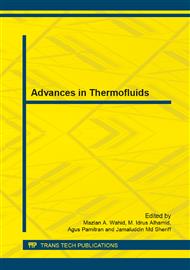p.63
p.71
p.76
p.83
p.91
p.96
p.101
p.106
p.111
Retrofitting R-22 Split Type Air Conditioning with Hydrocarbon (HCR-22) Refrigerant
Abstract:
An experimental study to evaluate the energy consumption of a split type air conditioning is presented. The compressor works with the fluids R-22 and HCR-22 and has been tested varying the internal heat load 0, 500, 700 and 1000 W. The measurements taken during the one hour experimental periods at 10-minutes interval times for temperature setpoint of 20oC. The performance data considered where the evaporator cooling load, the condenser heat rejection, the electrical energy consumption, the refrigeration system temperatures, and the room temperature. And hence the Coefficient of Performance (COP) could be determined. The final results of this study show an overall better energy consumption of the HFC-22 compared with the R-22.
Info:
Periodical:
Pages:
91-95
Citation:
Online since:
August 2013
Keywords:
Price:
Сopyright:
© 2013 Trans Tech Publications Ltd. All Rights Reserved
Share:
Citation:


